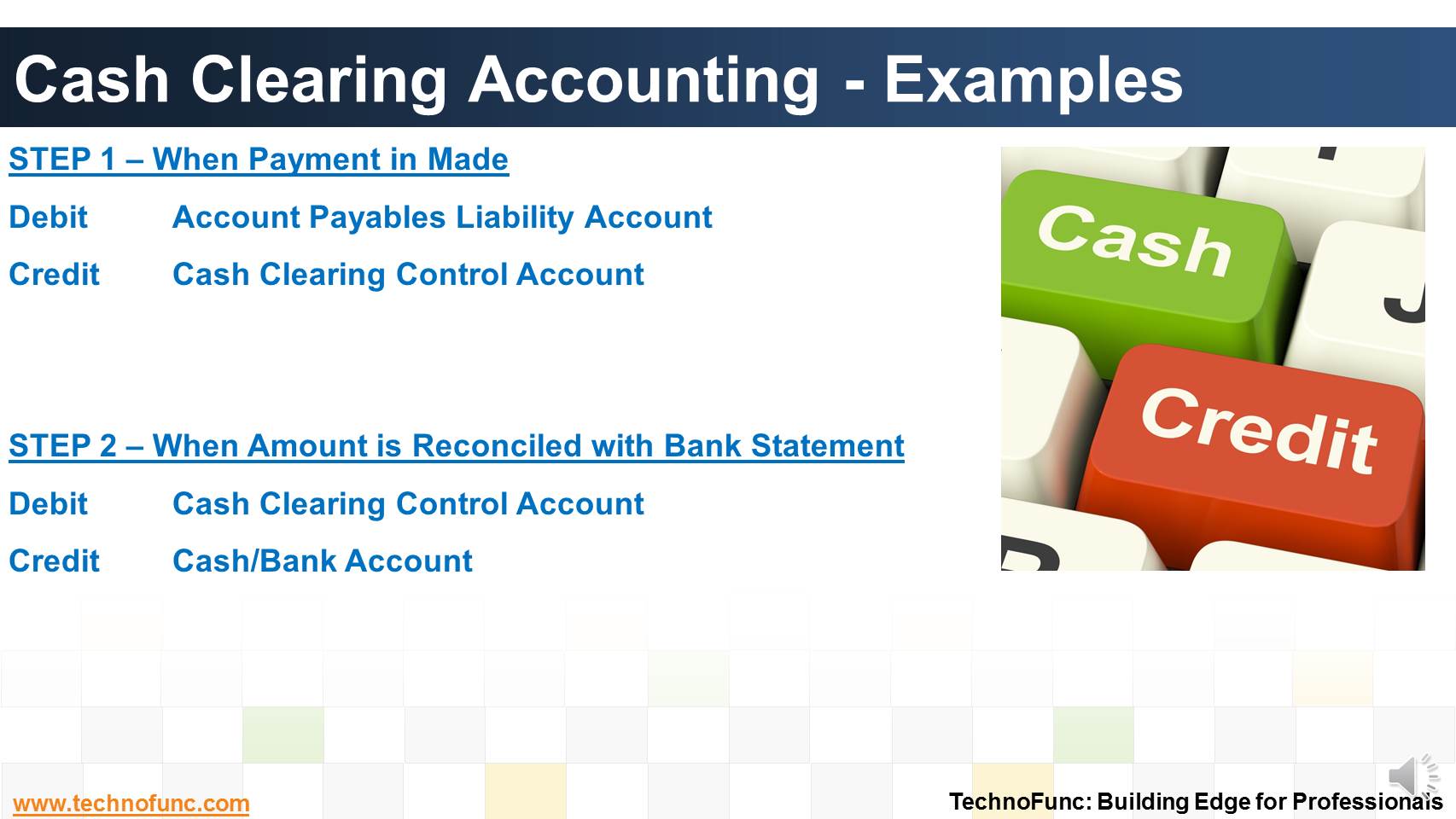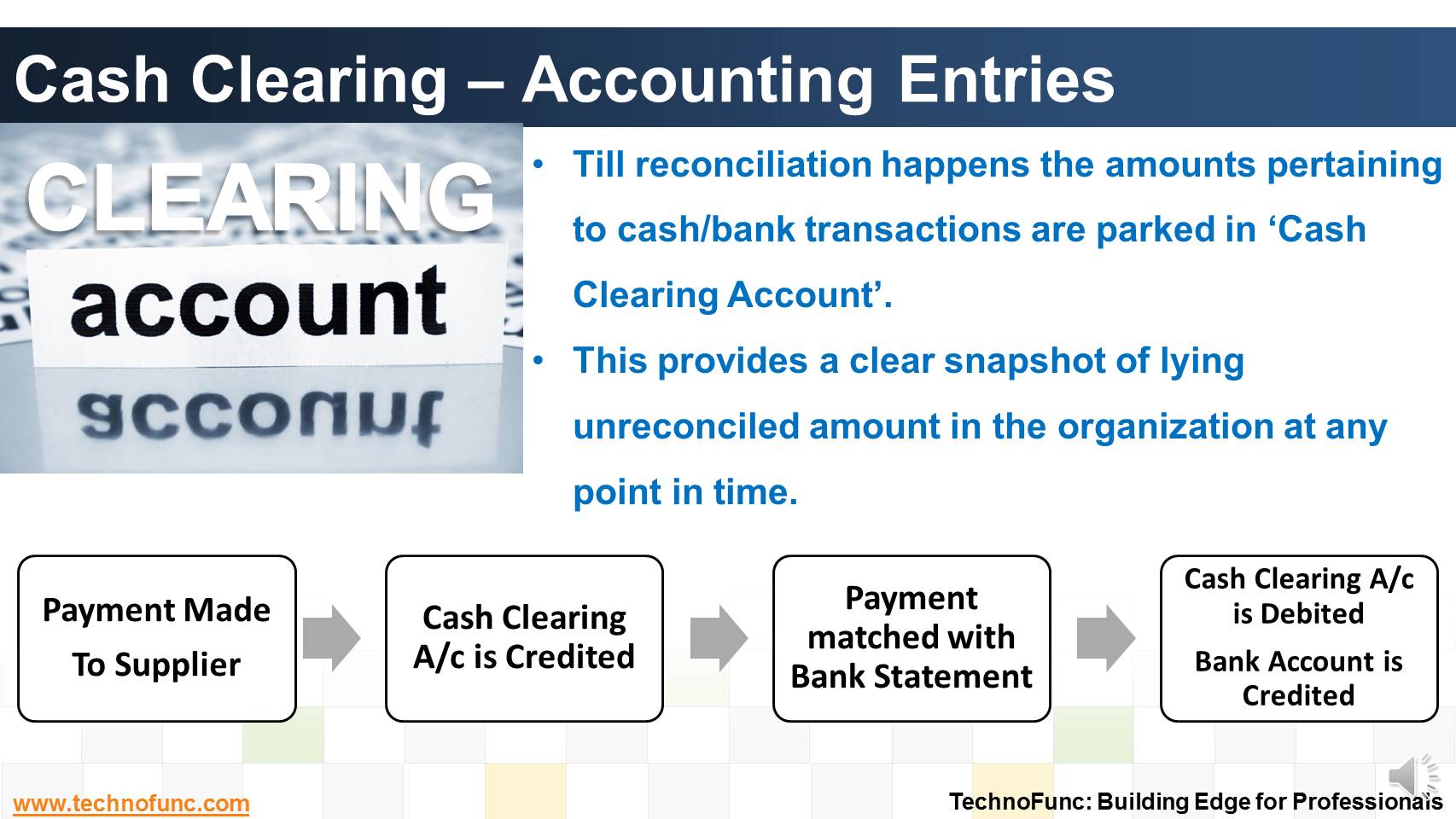- Home
- Business Processes
- Industry Knowledge
- Aerospace Industry
- Automotive Industry
- Banking Domain
- BFSI Industry
- Consumer/ FMCG Industry
- Chemicals Industry
- Engineering & Construction
- Energy Industry
- Education Domain
- Finance Domain
- Hospitality Domain
- Healthcare Industry
- Insurance Domain
- Retail Industry
- Travel and Tourism Domain
- Telecom Industry
- Leadership Skills
- eLearning
- Home
- Business Processes
- Cash Management
- Cash Clearing – Accounting Entries
Cash Clearing – Accounting Entries
The Cash Clearing process enables you to track amounts that have actually cleared your bank. Learn the steps and accounting entries that gets generated during the cash clearing process.
Cash Clearing Account
Till reconciliation happens the amounts pertaining to cash/bank transactions are parked in 'Cash Clearing Account'.
This method focuses on the use of a special cash-clearing control account to help provide an accurate cash-on-hand balance by including the effect of cash/bank transactions that have been issued, but have not yet cleared the bank in reconciliation system.
This provides a clear snapshot of lying unreconciled amount in the organization at any point in time.
For example – when you release payment to any supplier for his due invoice
You typically Dr Supplier A/c and Credit Bank Account
However in Cash Clearing Method – when you issue payment
You will Dr Supplier A/c and Credit Cash Clearing Account
Later when you receive the bank statement and reconcile the payment – at that point you will generate another accounting entry:
That is Cash Clearing A/c is Debited and Bank Account is Credited
Hence at this stage the payment hits your bank account – keeping it always reconciled.
Accounting Entries – Cash Clearing Process
The Cash Clearing process creates accounting entries for each scheduled payment that has been paid, reconciled, and cleared for bank accounts using cash clearing method of reconciliation.
These accounting entries are then posted to the general ledger.
Cash/Bank Clearing account is used to record unidentified debits and credits in bank statement.
At the time of reconciliation process, we have to debit or credit main account and offsetting will be done to Cash/Bank Clearing account.
Then only balance in the main account will match with Bank Statements.
Cash Clearing Accounting Examples
Cash clearing accounting for cash/bank transactions is a two-step process.
Step 1
When the payment is issued and posted, the accounts payable liability account is debited, and the cash clearing control account (as opposed to the actual cash account) is credited for the payment amount.
Step 2
Later, when the cash clearing request is processed, a pair of balanced accounting entries are created to clear the net cash amount of the issued payment for each payment that has been reconciled.
To determine the actual cash balance, add any debit or credit residue in the cash clearing control account from payment or deposit amounts that have not yet been cleared to the cash account balance.


Related Links
You May Also Like
-
The Cash Clearing process enables you to track amounts that have actually cleared your bank. Till reconciliation happens the amounts are parked in 'Cash Clearing Account'.
-
The terms Treasury Management and Cash Management are sometimes used interchangeably, while, in fact, the scope of treasury management is larger and includes funding and investment activities as well. Learn all about Treasury Management here!
-
Why enterprises need cash management. What is the purpose of having a well defined cash management process?
-
Many different accounts are used in finance. Understand the representation and nature of clearing account in context of accounting, finance and ERP Systems.
-
Introduction to Cash Clearing Process
Unravel the mystery behind clearing accounts. Learn why clearing accounts are used in finance and accounting. Learn why so many clearing accounts are defined in ERPs and Automated Accounting Systems.
-
How the inflow and outflow of cash is linked to the operating cycles of the business? Learn the cash management process in an enterprize and it's key components.
-
What are the various sources of cash in an organization. Which sources increase the cash available with the enterprise and which sources results in outflow of the cash? Let us explore!
-
So many codes in the lines that are there in a Bank Statement. It contain lots and lots of meaningful information that can help automated many tasks. Explore more!
-
Learning objectives for this lesson are: Meaning of Order to Cash Process; Sub Processes under Order to Cash; Process Flow for Order to Cash; Key Roles & Transactions; Key Setups/Master Data Requirements.
-
Complete Bank Reconciliation Process
Bank Reconciliation Process is a eight step process starting from uploading the Bank Statement to finally posting the entries in General Ledger. Learn the Eight Steps in Detail!
Explore Our Free Training Articles or
Sign Up to Start With Our eLearning Courses

About Us
Learning
© 2023 TechnoFunc, All Rights Reserved











